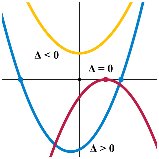|
|
|
|
|
||||||||||
|
|
||||||||||||||

UNIT 3 : QUADRATIC FUNCTIONS & EQUATIONS
LESSON
2: QUADRATIC EQUATIONS HOMEWORK
QUESTIONS

![]()
![]()
![]()
![]()
![]()
![]()
a) Write the function in vertex form.
b) State the vertex
c) State the equation of the axis of symmetry
d) State the direction of opening and any maximum or minimum value of f.
e) Sketch the graph using the vertex and 2 other points.
f) State the domain and range.
g) Calculate the discriminant b2 – 4ac and determine the number of zeros of the function
h) Find the zeros of the function.

![]()
![]()

Solutions:




![]()
Solutions:




![]()




![]()



![]()



![]()




![]()
a) Write the function in vertex form.
b) State the vertex
c) State the equation of the axis of symmetry
d) State the direction of opening and any maximum or minimum value of f.
e) Sketch the graph using the vertex and 2 other points.
f) State the domain and range.
g) Calculate the discriminant b2 – 4ac and determine the number of zeros of the function
h) Find the zeros of the function.
Solution:

Vertex at (0.25, -3.125). Since a > 0 the graph opens up and the function has a minimum value of y = -3.125 when x = 0.25.
The equation of the axis of symmetry is x = 0.25.
 y-intercept: let x = 0, then y = -3 giving point (0, -3)
y-intercept: let x = 0, then y = -3 giving point (0, -3)
Using symmetry – reflect point (0, -3) in the axis of symmetry [x = 0.25] to obtain
point (0.5, -3). [red dots on graph]
For the domain, the graph extends indefinitely to the left and right and there are no restrictions.
![]()
For the range, the smallest value for y is 3.125. There is no largest as the graph extends indefinitely upwards.
![]()
Discriminant: b2 – 4ac = (-1)2 –4(2)(-3) = +25. Hence there are two zeros.
Zeros: let y = 0 yielding 2x2 – x – 3 = 0. Solve by factoring (decomposition)
2x2 –3x + 2x – 3 = 0
x(2x – 3) + 1(2x – 3) = 0
(2x – 3)(x + 1) = 0
2x – 3 = 0 or x + 1 = 0
2x = 3 or x = -1
x = 3/2 or x = -1
[green dots on graph]

Solutions:
a = 3 b = 4 c= -1
a) f(x) = 3x2 + 4x – 1
b2 – 4ac = (4)2
– 4(3)(-1)
= 16
+ 12
= 28
Since b2
– 4ac > 0, there are 2 zeros.
The corresponding quadratic equation
3x2 + 4x – 1 = 0 has 2
real distinct roots.
a = -1 b = 0 c = 25
b) g(x) = 25 – x2
= -1x2 + 0x + 25
b2 – 4ac = (0)2 –
4(-1)(25)
= 100
Since b2 – 4ac > 0, there are 2 zeros. The corresponding quadratic equation 25 – x2 = 0 has 2 real distinct roots.
a = 4 b = -3 c = 3
c) y = 4x2 – 3x + 3
b2 – 4ac = (-3)2
– 4(4)(3)
= 9 – 48
= -39
Since b2
– 4ac < 0, there are no zeros.
The corresponding quadratic equation
4x2 - 3x + 3 = 0 has no
real roots.
a = 1 b = -10 c = 25
d) y = x2 – 10x + 25
b2
– 4ac = (-10)2 – 4(1)(25)
= 100 – 100
= 0
Since b2 – 4ac = 0, there is 1 zero. The corresponding quadratic equation x2 - 10x + 25 = 0 has real and equal roots.
![]()
Solution:
Exactly
1 zero means real equal roots or b2
– 4ac = 0.
a = k b = - 4 c = 2k
(-4)2 – 4(k)(2k) = 0
16 – 8k2
= 0
-8k2
= -16
k2
= 2
![]()






